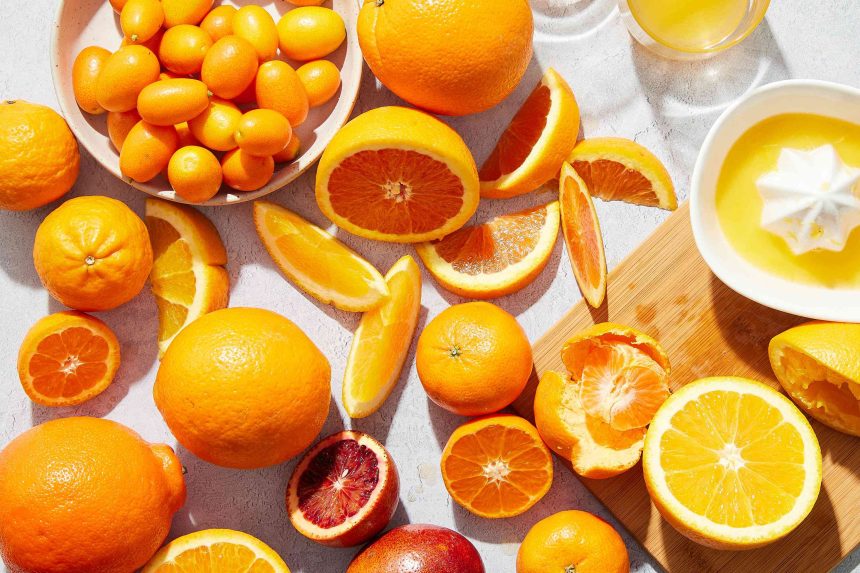When farmers markets close for the season and the weather dips below freezing, we often turn to frozen vegetables and fruits to bridge the gap until our gardens are in full bloom again. Still, there are a handful of winter fruits in season, which are available, budget-friendly, and flavorful in winter.
So what fruit is in season in winter? A bounty of citrus, a tropical fruit or two, and some festive holiday favorites. Read on to get a shortlist (that can double as a grocery shopping list) of winter fruits in season from November to March.
What’s Out of Season in Winter
Throughout all 12 months of the year, “it’s important and beneficial to incorporate different types of fruit into your meals and snacks each day to ensure you consume a variety of nutrients,” explains Meghan Sedivy, RD, a health and well-being program manager at Fresh Thyme Market in Chicago, Illinois. “While eating fresh, seasonal fruit is always top of mind, some fruits are not in season during the winter months.”
Fruits like cherries, berries, stone fruit, mangoes, and melons are summer fruits, so they’ll likely be pricier and less palatable than summer fruits in summer—or winter fruits in season.
While any fruit you can access is still a nutritious option, “summer seasonal fruits must be transported very long distances before making their way to grocery store shelves. That means they tend to have less flavor, fewer nutrients, and are more expensive in cold months,” says Sarah Brekke, M.S., Better Homes & Gardens Test Kitchen brand manager.
If you’d like to savor some berries, stone fruit, or other summer fruits, Sedivy suggests stocking up on frozen versions of these fruits because “they are picked, packed and frozen at peak ripeness for taste and nutrient-density,” she tells BHG. (For more about this, check out this deep-dive into frozen fruits and veggies.)
5 of the Best Winter Fruits in Season (When Little Else Is)
Another terrific way to get your antioxidants, fiber, and score a dose of hydrating foods—besides adding frozen fruit to your menu? Incorporating winter fruits to your meal plan during winter.
“During winter, it’s best to go for citrus fruits, pomegranates, pears, cranberries, and apples,” says Mackenzie Burgess, RDN, a Denver-based registered dietitian nutritionist and recipe developer at Cheerful Choices. “These fruits thrive during cooler months and are packed with vitamins, fiber, and antioxidants which can help support the immune system and combat winter colds.”
Over time, eating your recommended 1 ½ cups to 2 ½ cups of fruit per day has also been shown to help reduce the risk for certain chronic diseases, including heart disease, type 2 diabetes, and dementia.
The following fruits (and categories of fruits) are ripe and ready in winter, the dietitians we spoke to agree. Read on to learn about each of these winter fruits in season—and to score ideas for how to store and savor each of them.
Make the Most of Your Fresh Winter Fruit: “If you have extra winter fruit starting to go bad, flash freeze them on a baking sheet, then transfer to a bag for use in future smoothies or baked goods,” Burgess recommends.
Getty Images / Yingko
Pomegranates
“Fresh pomegranates are one of my favorite winter fruits, but they have a fairly short season: November through January,” says Roxana Ehsani, RD, a Miami-based board-certified sports dietitian.
So get them while you can to have a chance to get your fix of “pomegranate arils, which are little red ruby edible seeds that are juicy, deliciously sweet-tart, and packed with a variety of polyphenol antioxidants,” Ehsani adds.
You can buy arils in cups in the refrigerated part of the produce section, or for an even more affordable option, stock up on whole fruit.
“Whole pomegranates are quite hearty and can be stored in the refrigerator for up to 2 months but once opened, the seeds only last about 1 week,” Brekke says.
When you’re ready to dive in, wash the fruit just before cutting, then use a sharp knife to slice the fruit in half. Gently break the halves into smaller portions, then place those in a large bowl filled partially with water. Using your fingers, lightly agitate the seeds to loosen them from the membrane. Discard the skin and membrane that float to the top.
Try this winter fruits in salads; on top of oats, cereal, or yogurt; as part of a chocolate bark; as a garnish for chicken or seafood dishes; or in desserts like Maple Cheesecake with Vanilla Bean Whipped Cream, Pomegranate-Orange Cream Tart, or Pomegranate Pavlova with Pistachios and Honey.
Photo: Brie Goldman. Food: Annie Probst. Props: Breanna Ghazali
Kiwis
Kiwi season is long; running from October to May. So you have plenty of time to get your dose of these fuzzy-skinned fruits.
“Packed with vitamin C and fiber, kiwis help support immunity and healthy digestion,” Burgess says, in addition to reducing chronic inflammation and potentially supporting better sleep.
And since you can eat the skin, you get a lot for your dollar when you invest in kiwi. Store under-ripe kiwis at room temperature until they reach your desired level of ripeness (which can take around 5 to 7 days), then ripe kiwi in the fridge for up to a week, Brekke says. When you’re ready to enjoy, wash the fruit just before you plan to consume it, then try one of these 4 best ways to slice kiwi.
Enjoy them as-is, in fruit trifles or parfaits, as part of a fruit salsa or salad, or blended into smoothies.
Brie Goldman
Apples
Apples are typically thought of as fall fruits, and admittedly, harvest usually ends in October or November. However, many commercially-available apples are exposed to a perfectly-safe gas after picking, which extends their life for months.
Whether you opt for Honeycrisp or Granny Smith, eating a juicy, crunchy apple a day (or regularly) may help lower your blood pressure and bad cholesterol, tame chronic inflammation, and even reduce the risk for certain cancers. Apples are also a great source of soluble fiber, which supports gut health and aids digestion, Burgess adds.
Once you bring your apples home from the supermarket, store them in your refrigerator’s crisper drawer for 4 to 6 weeks, Brekke suggests. If you keep them in the pantry, “shelf life is reduced to 2 to 3 weeks,” she says.
Just before eating, wash your apples in a baking soda-infused water bath, then use a knife or apple corer to remove the core and seeds. Enjoy in its unadulterated glory, spread with nut butter, or put your apples to good use in pies, cakes, dumplings, quick bread, or as part of savory entrées like Chicken-Apple Burgers, Apple-Pecan Pork Chops, or Turkey-Apple Grilled Cheese Sandwiches.
Getty Images / Westend61
Cranberries
Similar to apples, fresh cranberries are harvested in the U.S. in fall (typically between mid-September and mid-November). They’re usually available fresh in bags in the produce aisle until January.
“Cranberries are known for supporting urinary tract health and are rich in antioxidants to help support immune function during these cold winter months,” Burgess says.
Store raw cranberries in their original packaging (often, a plastic bag) or transfer them to an airtight storage container and zip-top bag. Refrigerate for up to 1 month. Then before consuming these sweet-tart fruits, transfer them to a colander and rinse under cool running water. Use your clean hands to gently jostle the berries to ensure all pieces and sides are washed.
While you can safely eat cranberries raw, in salads and relishes, some folks find them extremely bitter or astringent. Cooking cranberries into muffins or breads, sauces, side dish casseroles, pancakes, or pies.
Citrus
“Citrus harvest begins in early fall and continues through winter and into spring, making it an excellent option for fruit during the colder months,” Ehsani says.
Everything from oranges (Sedivy is sweet on Sumas, Cara Caras, and blood oranges) and grapefruit to lemons and limes are at their peak in winter, and a lot of nutrition and sweet-tart tastiness is hiding right under the peel.
“The nutrients found in whole citrus fruit include vitamin C, thiamin, potassium, fiber, and folate, which contribute to overall health while supporting the immune system,” Ehsani says.
Store oranges, grapefruit, lemons, and limes at room temp for a week or in the fridge for up to 1 month, Brekke advises. Before delighting in your main squeeze, wash whole citrus fruits before cutting, then use a knife or your clean hands to slice or peel away the rind (including the white pith), Brekke suggests.
For oranges or grapefruits, “use a knife to cut the fruit into wedges or separate into segments by carefully cutting between the fruit and the inner membranes to remove individual segments. Add these to salads, overnight oats, drinks, or desserts. Or keep grapefruits in halves, sprinkle with sugar or brown sugar, and broil or heat with a kitchen torch until the sugar caramelizes.
For lemons or limes, use a citrus juicer to extract the liquid to use in dressings, drinks, desserts, or to add acidity to dishes. To prepare lemons or limes as a garnish for something like shrimp cocktail, tacos, or cocktails, cut the fruit in half and then cut into slices or wedges.







